Observations of the Boundary Layer in the Cape Grim Coastal Region: Interaction with Wind and the Influences of Continental Sources
Abstract
:1. Introduction
2. Site, Measurements, and Model Data
2.1. Site
2.2. Measurements
2.2.1. Ceilometer
2.2.2. Sodar
2.2.3. Near-Surface Measurements
2.3. ECMWF-ERA5 Data
2.4. Backward Trajectories
3. Methods for BLH Detection
4. Results and Discussion
4.1. Synoptic Conditions
4.2. Event 1: 3 June 2019
4.3. Event 2: 25 June 2019
5. Discussion: BLH Estimations under Different Sources
6. Conclusions
Author Contributions
Funding
Data Availability Statement
Conflicts of Interest
References
- Stull, R.B. An Introduction to Boundary Layer Meteorology; Kluwer Academic Publishers: Norwell, MA, USA, 1988. [Google Scholar]
- Seaman, N.L. Meteorological modeling for air-quality assessments. Atmos. Environ. 2000, 34, 2231–2259. [Google Scholar] [CrossRef]
- Skamarock, W.C.; Klemp, J.B.; Dudhia, J.; Gill, D.O.; Barker, D.M.; Duda, M.G.; Huang, X.Y.; Wang, W.; Powers, J.G. A description of the advanced research WRF Version 3. NCAR Tech. Note 2008, 125, 1–3. [Google Scholar]
- Peña, A.; Gryning, S.E.; Hahmann, A.N. Observations of the atmospheric boundary layer height under marine upstream flow conditions at a coastal site. J. Geophys. Res. 2013, 118, 1924–1940. [Google Scholar] [CrossRef]
- Mace, G.G.; Protat, A. Clouds over the Southern Ocean as Observed from the R/V Investigator during CAPRICORN. Part II: The Properties of Nonprecipitating Stratocumulus. J. Appl. Meteorol. Clim. 2018, 57, 1805–1823. [Google Scholar] [CrossRef]
- Welton, E.J.; Voss, K.J.; Gordon, H.R.; Maring, H.; Smirnov, A.; Holben, B.; Schmid, B.; Livingston, J.M.; Russell, P.B.; Durkee, P.A.; et al. Ground-based lidar measurements of aerosols during ACE-2: Instrument description, results, and comparisons with other ground-based and airborne measurements. Tellus B 2000, 52, 636–651. [Google Scholar] [CrossRef] [Green Version]
- Emeis, S.; Schäfer, K.; Münkel, C. Observation of the structure of the urban boundary layer with different ceilometers and validation by RASS data. Meteorol. Z. 2009, 18, 149–154. [Google Scholar] [CrossRef]
- Groß, S.; Tesche, M.; Freudenthaler, V.; Toledano, C.; Wiegner, M.; Ansmann, A.; Althausen, D.; Seefeldner, M. Characterization of Saharan dust, marine aerosols and mixtures of biomass-burning aerosols and dust by means of multi-wavelength depolarization and Raman lidar measurements during SAMUM 2. Tellus B 2011, 63, 706–724. [Google Scholar] [CrossRef]
- Bravo-Aranda, J.A.; Moreira, G.A.; Navas-Guzman Granados-Munoz, M.J.; Gurrero-Rascado, J.L.; Pozo-Vazquez, D.; Arbizu-Barrena, C.; Reyes, F.J.O.; Mallet, M.; Arboledas, L.A. A new methodology for PBL height estimations based on lidar depolarization measurements: Analysis and comparison against NWR and WRF model-based results. Atmos. Chem. Phys. 2017, 17, 6839–6851. [Google Scholar] [CrossRef] [Green Version]
- Su, T.; Li, J.; Li, C.; Xiang, P.; Lau, A.K.-H.; Guo, J.; Yang, D.; Miao, Y. An intercomparison of long-term planetary boundary layer heights retrieved from CALIPSO, ground-based lidar, and radiosonde measurements over Hong Kong. J. Geophys. Res. Atmos. 2017, 122, 3929–3943. [Google Scholar] [CrossRef]
- Alexander, S.P.; Protat, A. Vertical profiling of aerosols with a combined raman-elastic backscatter lidar in the remote Southern Ocean marine boundary layer (43–66° S, 132–150° E). J. Geophys. Res. 2019, 124, 12107–12125. [Google Scholar] [CrossRef]
- Tangborn, A.; Demoz, B.; Carroll, B.J.; Santanello, J.; Anderson, J.L. Assimilation of lidar planetary boundary layer height observations. Atmos. Meas. Tech. 2021, 14, 1009–1110. [Google Scholar] [CrossRef]
- Duenas, C.; Perez, M.; Fernandez, M.C.; Carretero, J. Radon concentrations in surface air and vertical atmospheric stability of the lower atmosphere. J Environ. Radioact. 1996, 31, 87–102. [Google Scholar] [CrossRef]
- Salzano, R.; Pasini, A.; Casasanta, G.; Cacciani, G.; Perrino, C. Quantitative Interpretation of Air Radon Progeny Fluctuations in Terms of Stability Conditions in the Atmospheric Boundary Layer. Bound.-Layer Meteorol. 2016, 160, 529–550. [Google Scholar] [CrossRef]
- Crawford, J.; Chambers, S.D.; Williams, A.G. Assessing the impact of synoptic weather systems on air quality in Sydney using Radon 222. Atmos. Environ. 2022, 295, 119537. [Google Scholar] [CrossRef]
- Sesana, L.; Caprioli, E.; Marcazzan, G.M. Long period study of outdoor radon concentration in Milan and correlation between its temporal variations and dispersion properties of atmosphere. J. Environ. Radioact. 2003, 65, 147–160. [Google Scholar] [CrossRef]
- Keller, C.A.; Huwald, H.; Vollmer, M.K.; Wenger, A.; Hill, M.; Parlange, M.B.; Reimannet, S. Fiber optic distributed temperature sensing for the determination of the nocturnal atmospheric boundary layer height. Atmos. Meas. Tech. 2011, 4, 143–149. [Google Scholar] [CrossRef] [Green Version]
- Vecchi, R.; Piziali, F.A.; Valli, G.; Favaron, M.; Bernardoni, V. Radon-based estimates of equivalent mixing layer heights. Atmos. Environ. 2019, 197, 150–158. [Google Scholar] [CrossRef]
- Emeis, S.; Schäfer, K.; Münkel, C.; Friedl, R.; Suppan, P. Evaluation of the interpretation of ceilometer data with RASS and radiosonde data. Bound.-Layer Meteorol. 2012, 143, 25–35. [Google Scholar] [CrossRef]
- Pichelli, E.; Ferretti, R.; Cacciani MSiani, A.M.; Ciardini, V.; Iorio, T.D. The role of urban boundary layer investigated with high-resolution models and ground-based observations in Rome area: A step towards understanding parameterization potentialities. Atmos. Meas. Tech. 2014, 7, 315–332. [Google Scholar] [CrossRef] [Green Version]
- Poltera, Y.; Martucci, G.; Collaud Coen, M.; Hervo, M.; Emmenegger, L.; Henne, S.; Brunner, D.; Haefele, A. PathfinderTURB: An automatic boundary layer algorithm. Development, validation and application to study the impact on in situ measurements at the Jungfraujoch. Atmos. Chem. Phys. 2017, 17, 10051–10070. [Google Scholar] [CrossRef] [Green Version]
- Steyn, D.G.; Baldi, M.; Hoff, R.M. The detection of mixed layer depth and entrainment zone thickness from lidar backscatter profiles. J. Atmos. Ocean. Technol. 1999, 16, 953–959. [Google Scholar] [CrossRef]
- Flamant, C.; Pelon, J.; Flamant, P.H.; Durand, P. Lidar determination of the entrainement zone thickness at the top of the unstable marine atmospheric boundary-layer. Bound.-Layer Meteorol. 1997, 83, 247–284. [Google Scholar] [CrossRef]
- Baars, H.; Ansmann, A.; Engelmann, R.; Althausen, D. Continuous monitoring of the boundary-layer top with lidar. Atmos. Chem. Phys. 2008, 8, 7281–7296. [Google Scholar] [CrossRef] [Green Version]
- Chen, Z.Y.; Schofield, R.; Rayner, P.; Liu, C.; Vincent, C.; Fiddes, S.; Ryan, R.G.; Alroe, J.; Ristovski, Z.; Shu, X.W. Characterization of aerosols over the Great Barrier Reef: The influence of transported continental sources. Sci. Total Environ. 2019, 690, 426–437. [Google Scholar] [CrossRef]
- Hooper, W.P.; Florante, E.W. Lidar measurements of wind in the planetary boundary layer: The method, accuracy and results from joint measurements with radiosonde and kytoon. J. Clim. Appl. Meteor. 1986, 25, 990–1001. [Google Scholar] [CrossRef]
- Hennemuth, B.; Lammert, A. Determination of the atmospheric boundary layer height from radiosonde and lidar backscatter. Bound.-Layer Meteorol. 2006, 120, 181–200. [Google Scholar] [CrossRef]
- de Bruine, M.; Apituley, A.; Donovan, D.P.; Klein Baltink, H.; de Haij, M.J. Pathfinder: Applying graph theory to consistent tracking of daytime mixed layer height with backscatter lidar. Atmos. Meas. Tech. 2017, 10, 1893–1909. [Google Scholar] [CrossRef] [Green Version]
- Rieutord, T.; Aubert, S.; Machado, T. Deriving boundary layer height from aerosol lidar using machine learning: KABL and ADABL algorithms. Atmos. Meas. Tech. 2021, 14, 4335–4353. [Google Scholar] [CrossRef]
- Haeffelin, M.; Angelini, F.; Morille, Y.; Martucci, G.; Frey, S.; Gobbi, G.; Lolli, S.; O’dowd, C.; Sauvage, L.; Xueref-Rémy, I.; et al. Evaluation of mixing-height retrievals from automatic profiling lidars and ceilometers in view of future integrated networks in Europe. Bound.-Layer Meteorol. 2012, 143, 49–75. [Google Scholar] [CrossRef]
- Lewis, J.R.; Welton, E.J.; Molod, A.M.; Joseph, E. Improved boundary layer depth retrievals from MPLNET. J. Geophys. Res.-Atmos. 2013, 118, 9870–9879. [Google Scholar] [CrossRef]
- Vivone, G.; D’Amico, G.; Summa, D.; Lolli, S.; Amodeo, A.; Bortoli, D.; Pappalardo, G. Atmospheric boundary layer height estimation from aerosol lidar: A new approach based on morphological image processing techniques. Atmos. Chem. Phys. 2021, 21, 4249–4265. [Google Scholar] [CrossRef]
- Zahorowski, W.; Chambers, S.; Wang, T.; Kang, C.H.; Uno, I.; Poon, S.; Oh, S.N.; Werczynski, S.; Kim, J.; Henderson-Sellers, A.N.N. Radon-222 in boundary layer and free tropospheric continental outflow events at three ACE-Asia sites. Tellus B 2005, 57, 124–140. [Google Scholar] [CrossRef]
- Deardorff, J.W.; Willis, G.E.; Stockton, B.H. Laboratory studies of the entrainment zone of a convectively mixed layer. J. Fluid Mech. 1980, 100, 41–64. [Google Scholar] [CrossRef]
- Münkel, C.; Eresmaa, N.; Räsänen, J.; Karppinen, A. Retrieval of Mixing Height and Dust Concentration with Lidar Ceilometer. Bound.-Layer Meteorol. 2007, 124, 117–128. [Google Scholar] [CrossRef]
- Wiegner, M.; Gasteiger, J. Correction of water vapor absorption for aerosol remote sensing with ceilometers. Atmos. Meas. Tech. 2015, 8, 3971–3984. [Google Scholar] [CrossRef] [Green Version]
- Martucci, G.; Milroy, C.; O’Dowd, C.D. Detection of Cloud-Base Height Using Jenoptik CHM15K and Vaisala Ceilometers. J. Atmos. Ocean. Technol. 2010, 27, 305–318. [Google Scholar] [CrossRef]
- Tsaknakis, G.; Papayannis, A.; Kokkalis, P.; Amiridis, A.; Kambezidis, H.; Mamouri, R.; Georgoussis, G.; Advikos, G. Inter-comparison of Lidar and Ceilometer Retrievas for Aerosol and Planetary Boundary Layer Profiling over Athens, Greece. Atmos. Meas. Tech. 2011, 4, 1261–1273. [Google Scholar] [CrossRef] [Green Version]
- Wyngaard, J.C.; Lemone, M.A. Behavior of the refractive index structure parameter in the entraining convective boundary layer. J. Atmos. Sci. 1980, 37, 1573–1585. [Google Scholar] [CrossRef]
- Beyrich, F.; Gryning, S.E. Estimation of the entrainment zone depth in a shallow convective boundary layer from sodar data. J. Appl. Meteorol. 1998, 37, 255–268. [Google Scholar] [CrossRef]
- Helmis, C.G.; Flocas, H.A.; Kalogiros, J.A.; Asimakopoulos, D.N. Strong down slope winds and application of hydraulic-like theory. J. Geophys Res. Clim. Phys. Atmos. 2000, 105, 18039–18051. [Google Scholar] [CrossRef]
- Behrens, P.; Bradley, S.; Wiens, T. A multisodar approach to wind profiling. J. Atmos. Ocean. Technol. 2010, 27, 1165–1174. [Google Scholar] [CrossRef]
- Saha, S.; Sharma, S.; Kumar, K.N.; Kumar, P.; Lal, S.; Kamat, D. Investigation of Atmospheric Boundary Layer characteristics using Ceilometer Lidar, COSMIC GPS RO satellite, Radiosonde and ERA-5 reanalysis dataset over Western Indian Region. Atmos. Res. 2022, 268, 105999. [Google Scholar] [CrossRef]
- Palm, S.P.; Benedetti, A.; Spinhirne, J. Validation of ECMWF global forecast model parameters using GLAS atmospheric channel measurements. Geophys. Res. Lett. 2005, 32, L22S09. [Google Scholar] [CrossRef]
- Draxler, R.R.; Rolph, G.D. HYSPLIT (HYbrid Single-Particle Lagrangian Integrated Trajectory) Model Access via NOAA ARL READY Website (http://www.arl.noaa.gov/HYSPLIT.php); NOAA Air Resources Laboratory: College Park, MD, USA, 2013. [Google Scholar]
- Heese, B.; Flentje, H.; Althausen, D.; Ansmann, A.; Frey, S. Ceilometer lidar comparison: Backscatter coefficient retrieval and signal-to-noise ratio determination. Atmos. Meas. Tech. 2010, 3, 1763–1770. [Google Scholar] [CrossRef] [Green Version]
- Xiang, Y.; Zhang, T.S.; Liu, J.G.; Lv, L.H.; Dong, Y.S.; Chen, Z.Y. Atmosphere boundary layer height and its effect on air pollutants in Beijing during winter heavy pollution. Atmos. Res. 2019, 21, 305–316. [Google Scholar] [CrossRef]
- Jones, D.; Simmonds, I. A climatology of Southern Hemisphere anticyclones. Clim. Dyn. 1994, 10, 333–348. [Google Scholar] [CrossRef]
- Alapaty, K.; Pleim, J.E.; Raman SDNiyogi, S.; Byun, D.W. Simulation of atmospheric boundary layer processes using local- and nonlocal-closure schemes. J. Appl. Meteorol. 1997, 36, 214–223. [Google Scholar] [CrossRef]
- Madonna, F.; Summa, D.; Girolamo, P.D.; Marra, F.; Wang, Y.Z.; Rosoldi, M. Assessment of trends and uncertainties in the atmospheric boundary layer height estimated using radio sounding observations over Europe. Atmosphere 2021, 12, 301. [Google Scholar] [CrossRef]
- Guo, J.P.; Zhang, J.; Yang, H.L.; Zhang, S.D.; Huang, K.M.; Lv, Y.M.; Shao, J.; Yu, T.; Tong, B.; Li, J.; et al. Investigation of near-global daytime boundary layer height using high-resolution radiosondes: First results and comparison with ERA5, MERRA-2, JRA-55, and NCEP-2 reanalyses. Atmos. Chem. Phys. 2021, 21, 17079–17097. [Google Scholar] [CrossRef]
- Gu, J.; Zhang, Y.H.; Yang, N.; Wang, R. Comparisons in the global planetary boundary layer height obtained from COSMIC radio occultation, radiosonde, and reanalysis data. Atmos. Ocean. Sci. Lett. 2021, 14, 100018. [Google Scholar] [CrossRef]
- Luo, T.; Wang, Z.E.; Zhang, D.M.; Chen, B. Marine boundary layer structure as observed by A-train satellites. Atmos. Chem. Phys. 2016, 16, 5891–5903. [Google Scholar] [CrossRef]
- Busse, J.; Knupp, K. Observed Characteristics of the Afternoon-Evening Boundary Layer Transition Based on Sodar and Surface Data. J. Appl. Metrol. Clim. 2012, 51, 571–582. [Google Scholar] [CrossRef]
- Li, Z.Q.; Guo, J.P.; Ding, A.J.; Liao, H.; Liu, J.J.; Sun, Y.L.; Wang, T.J.; Xue, H.W.; Zhang, H.S.; Zhu, B. Aerosol and boundary-layer interactions and impact on air quality. Natl. Sci. Rev. 2017, 4, 810–833. [Google Scholar] [CrossRef]
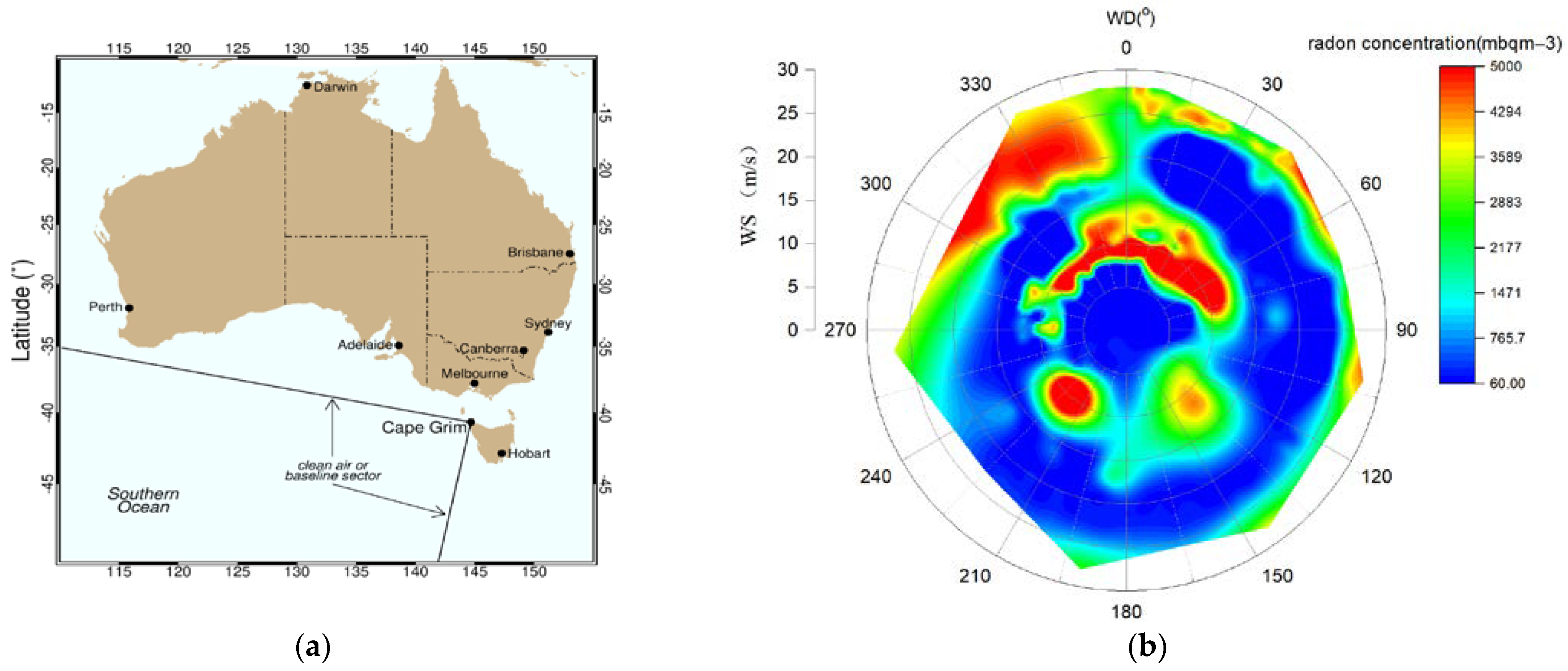
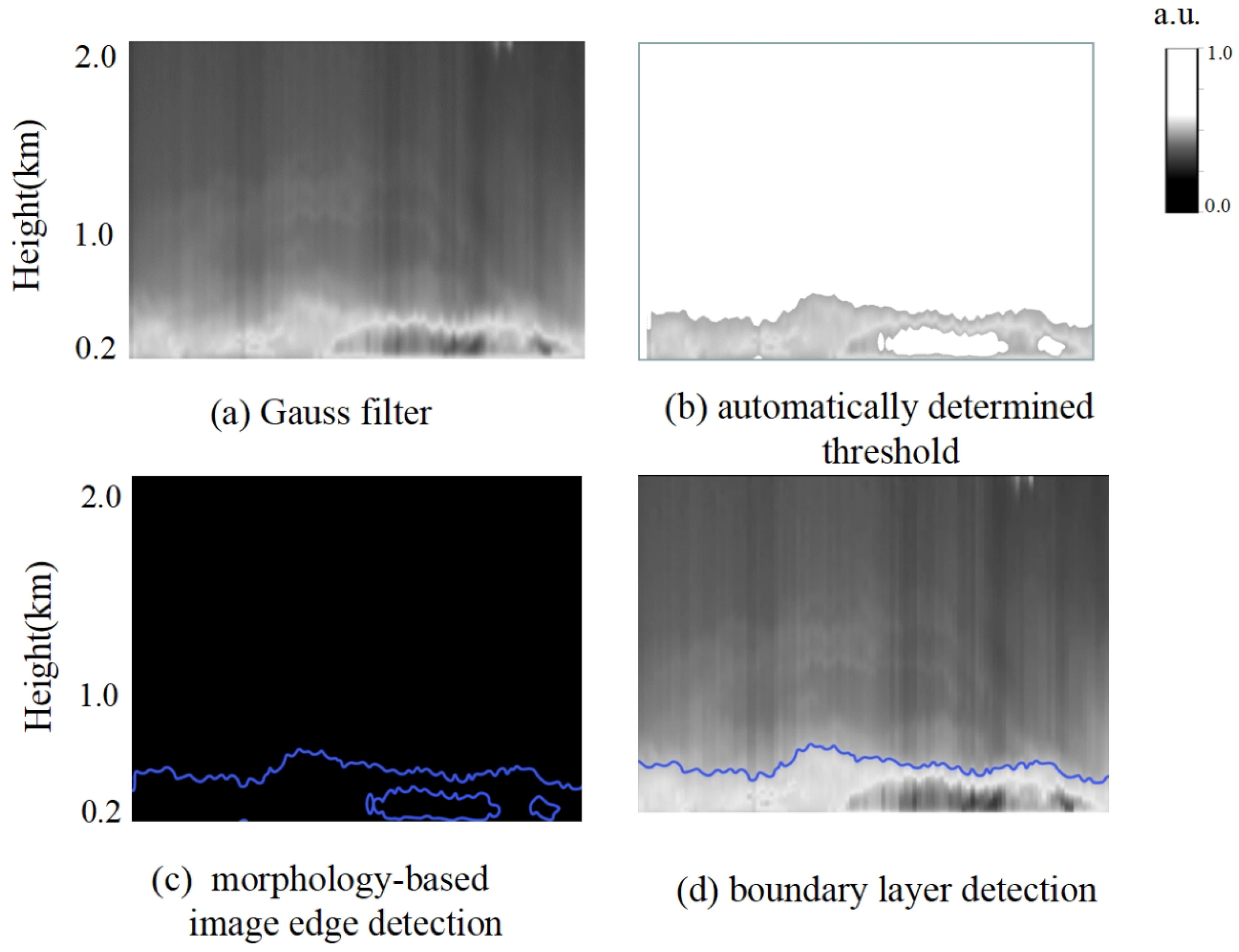
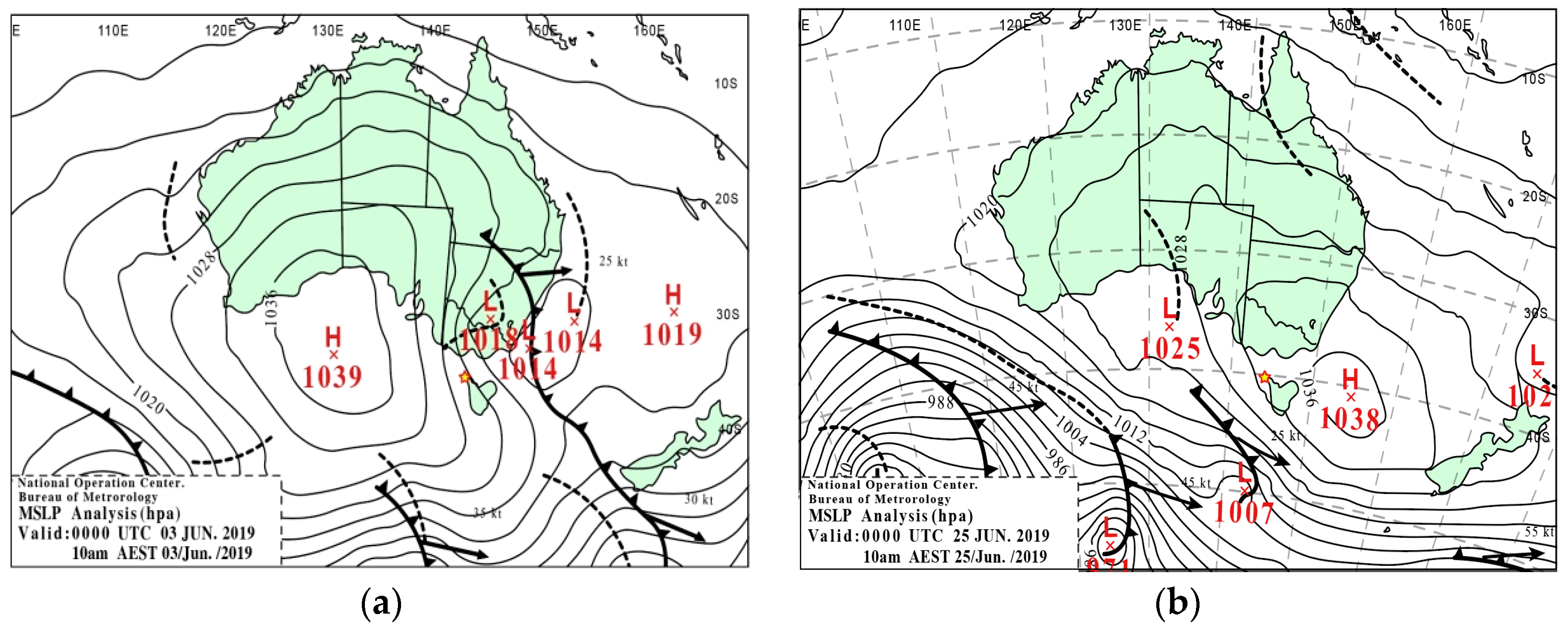
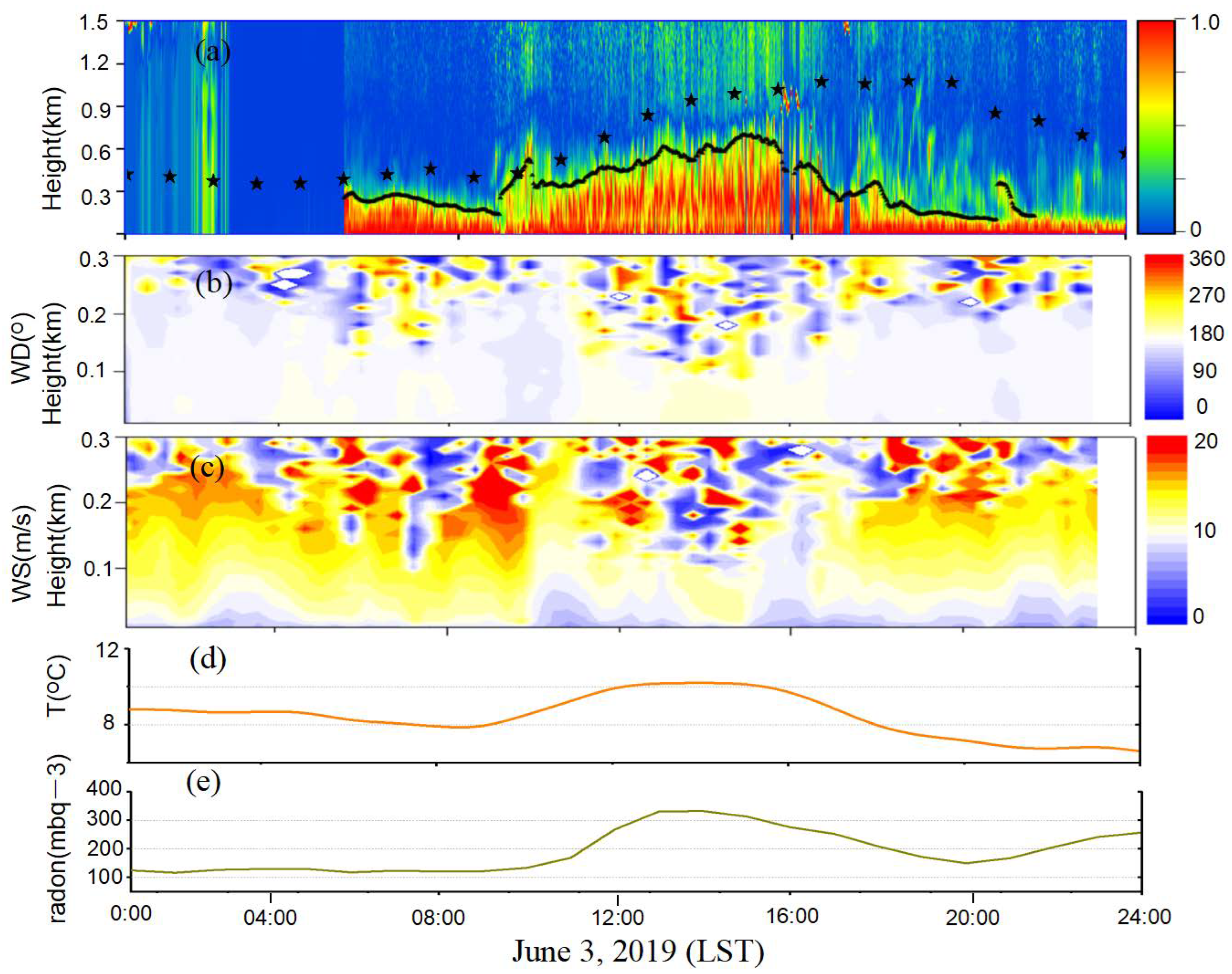
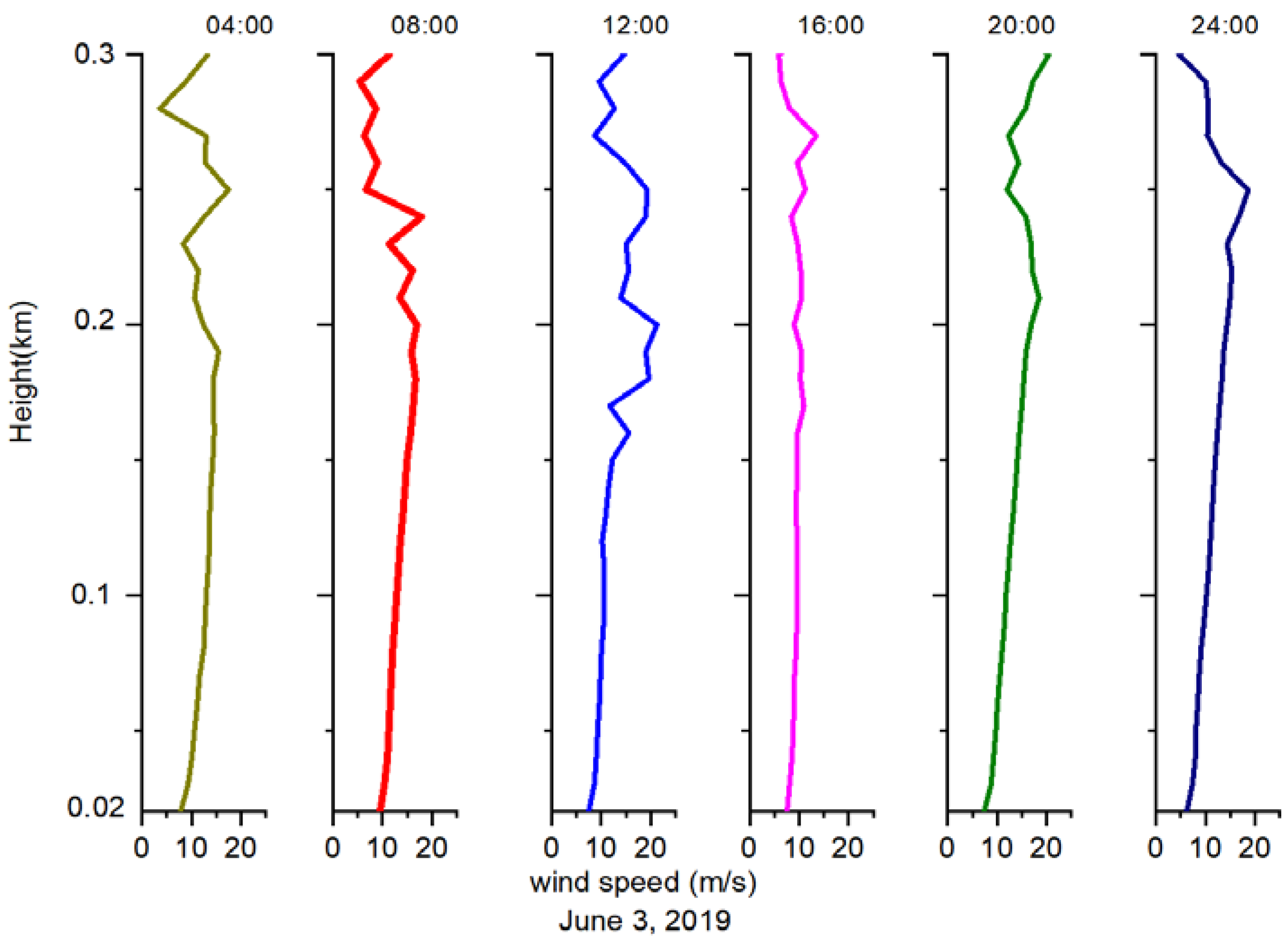
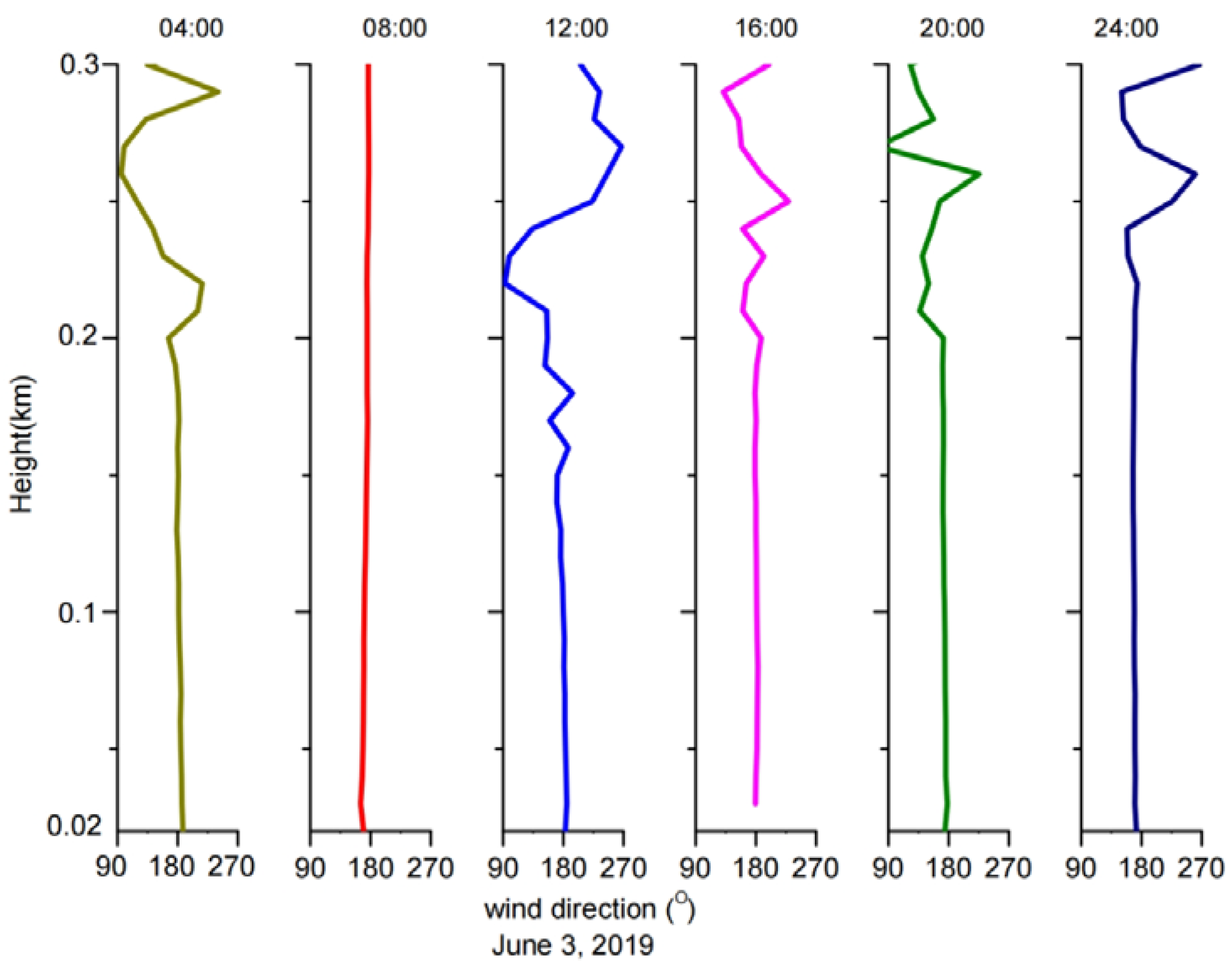



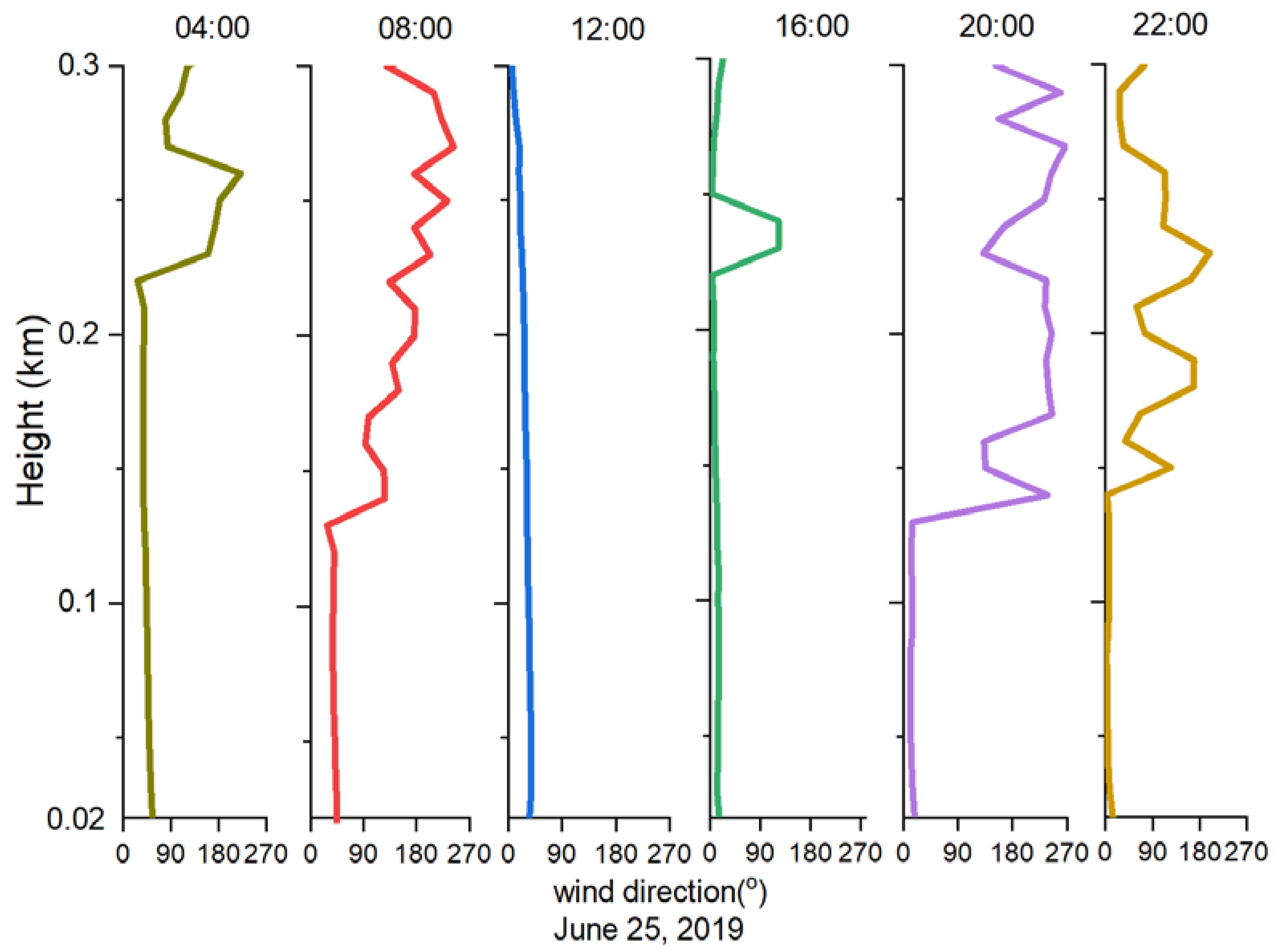
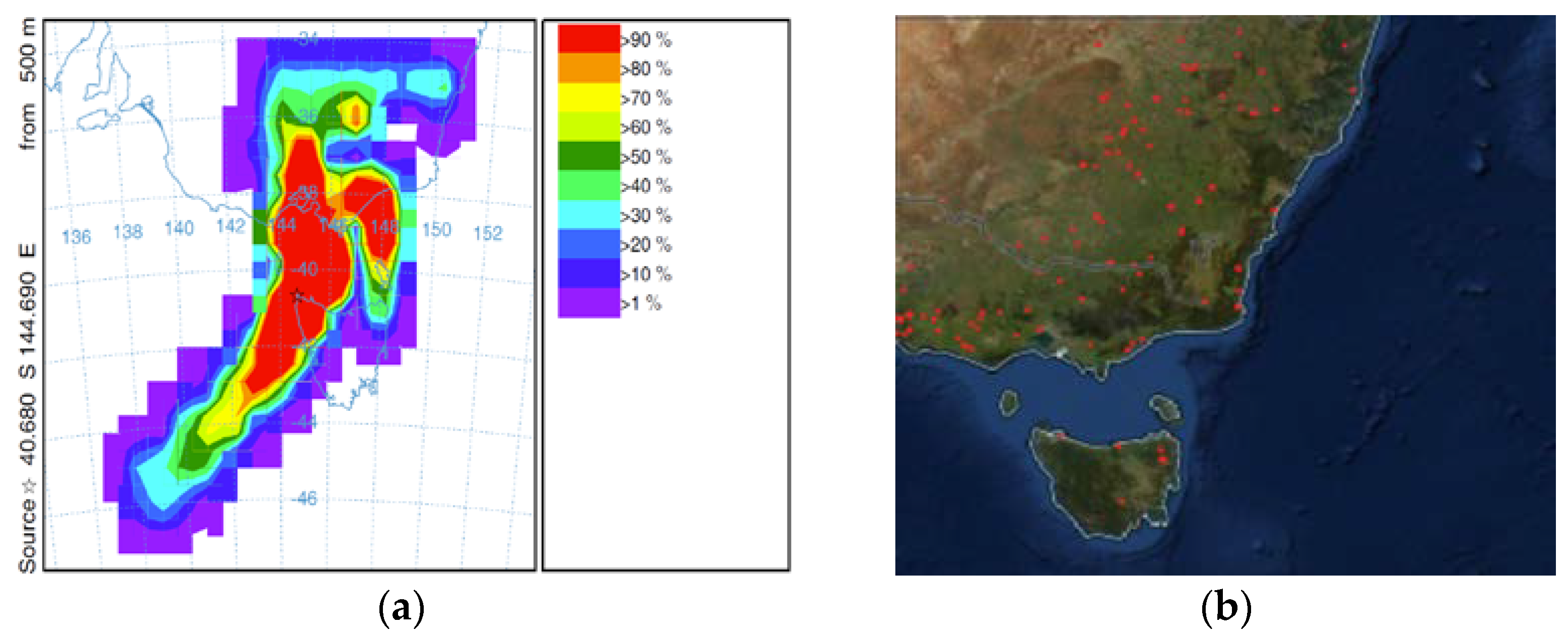

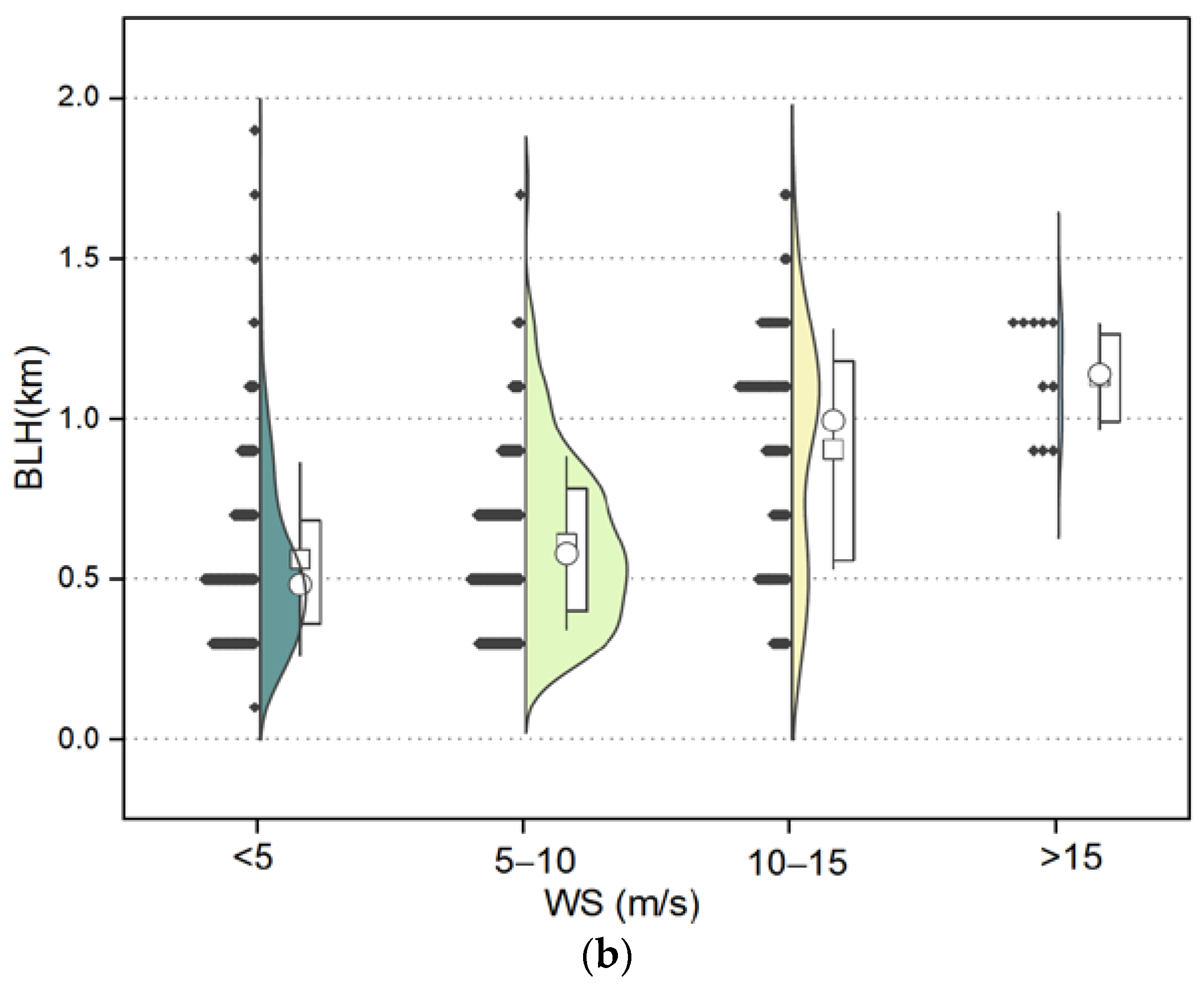
Disclaimer/Publisher’s Note: The statements, opinions and data contained in all publications are solely those of the individual author(s) and contributor(s) and not of MDPI and/or the editor(s). MDPI and/or the editor(s) disclaim responsibility for any injury to people or property resulting from any ideas, methods, instructions or products referred to in the content. |
© 2023 by the authors. Licensee MDPI, Basel, Switzerland. This article is an open access article distributed under the terms and conditions of the Creative Commons Attribution (CC BY) license (https://creativecommons.org/licenses/by/4.0/).
Share and Cite
Chen, Z.; Schofield, R.; Keywood, M.; Cleland, S.; Williams, A.G.; Wilson, S.; Griffiths, A.; Xiang, Y. Observations of the Boundary Layer in the Cape Grim Coastal Region: Interaction with Wind and the Influences of Continental Sources. Remote Sens. 2023, 15, 461. https://doi.org/10.3390/rs15020461
Chen Z, Schofield R, Keywood M, Cleland S, Williams AG, Wilson S, Griffiths A, Xiang Y. Observations of the Boundary Layer in the Cape Grim Coastal Region: Interaction with Wind and the Influences of Continental Sources. Remote Sensing. 2023; 15(2):461. https://doi.org/10.3390/rs15020461
Chicago/Turabian StyleChen, Zhenyi, Robyn Schofield, Melita Keywood, Sam Cleland, Alastair G. Williams, Stephen Wilson, Alan Griffiths, and Yan Xiang. 2023. "Observations of the Boundary Layer in the Cape Grim Coastal Region: Interaction with Wind and the Influences of Continental Sources" Remote Sensing 15, no. 2: 461. https://doi.org/10.3390/rs15020461





